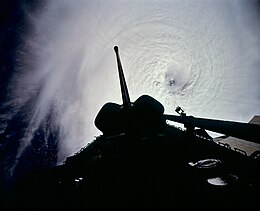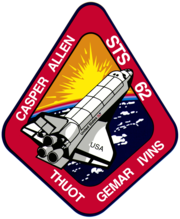This article includes a list of general references, but it lacks sufficient corresponding inline citations. (May 2008) |
 Columbia passes over Typhoon Owen. | |
| Names | Space Transportation System-62 |
|---|---|
| Mission type | Microgravity research |
| Operator | NASA |
| COSPAR ID | 1994-015A |
| SATCAT no. | 23025 |
| Mission duration | 13 days, 23 hours, 16 minutes, 41 seconds |
| Distance travelled | 9,366,617 kilometres (5,820,146 mi) |
| Orbits completed | 224 |
| Spacecraft properties | |
| Spacecraft | Space Shuttle Columbia |
| Landing mass | 102,861 kilograms (226,770 lb) |
| Payload mass | 8,759 kilograms (19,310 lb) |
| Crew | |
| Crew size | 5 |
| Members | |
| Start of mission | |
| Launch date | 4 March 1994, 13:53:01 UTC |
| Launch site | Kennedy, LC-39B |
| End of mission | |
| Landing date | 18 March 1994, 13:10:42 UTC |
| Landing site | Kennedy, SLF Runway 33 |
| Orbital parameters | |
| Reference system | Geocentric |
| Regime | Low Earth |
| Perigee altitude | 296 kilometres (184 mi) |
| Apogee altitude | 309 kilometres (192 mi) |
| Inclination | 39.00 degrees |
| Period | 90.4 minutes |

 Left to right - Standing: Gemar, Ivins, Thuot; Seated: Allen, Casper | |
STS-62 was a Space Shuttle program mission flown aboard Space Shuttle Columbia. The primary payloads were the USMP-02 microgravity experiments package and the OAST-2 engineering and technology payload, both in the orbiter's cargo bay. The two-week mission also featured a number of biomedical experiments focusing on the effects of long duration spaceflight. The landing was chronicled by the 1994 Discovery Channel special about the Space Shuttle program and served as the show's opening. A C.F. Martin backpacker guitar was also flown aboard Columbia during the mission.